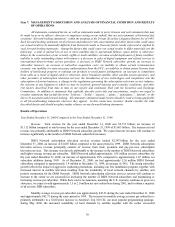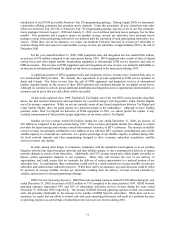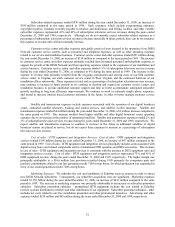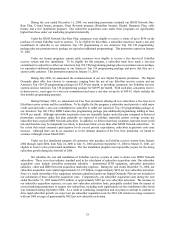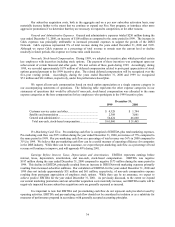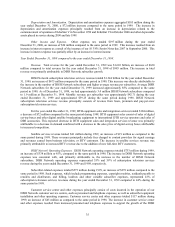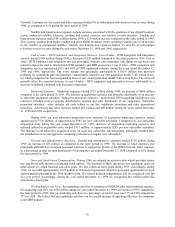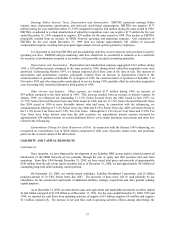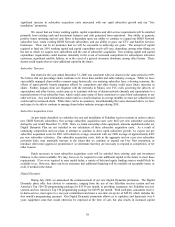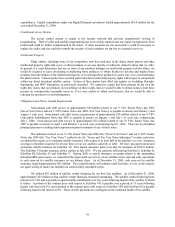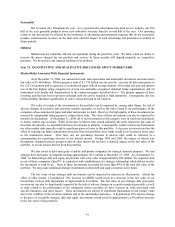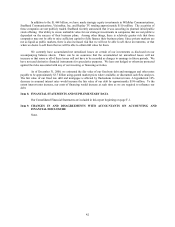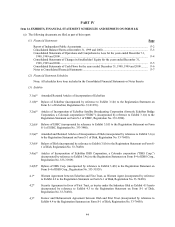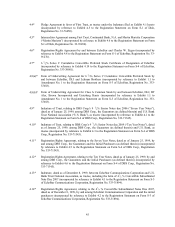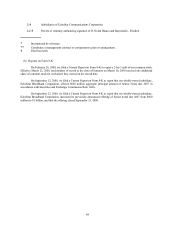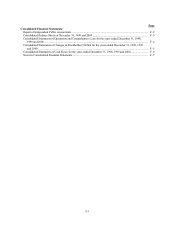Dish Network 2000 Annual Report Download - page 42
Download and view the complete annual report
Please find page 42 of the 2000 Dish Network annual report below. You can navigate through the pages in the report by either clicking on the pages listed below, or by using the keyword search tool below to find specific information within the annual report.40
Dividends on our 6 3/4% Series C Cumulative Convertible Preferred Stock began to accrue on
November 2, 1999. Holders of the Series C Preferred Stock are entitled to receive cumulative dividends at an annual
rate of 6 3/4% of the Liquidation Preference of $50 per share. Dividends are payable quarterly in arrears, commencing
February 1, 2000, when, as, and if declared by our Board of Directors. All accumulated and unpaid dividends may, at
our option, be paid in cash, Class A common stock, or a combination thereof upon conversion or redemption.
During 2001, we anticipate total capital expenditures of between $600-$900 million depending upon the
strength of the economy and other factors. We expect approximately 40% of that amount to be utilized for satellite
construction and approximately 60% for EchoStar receiver systems in connection with our Digital Dynamite Plan and
for general corporate expansion. Our anticipated capital expenditures related to the Digital Dynamite promotion may
materially increase to the extent this promotion is successful and to the extent that we continue or expand our Digital
Dynamite promotion.
In addition to our DBS business plan, we have licenses, or applications pending with the FCC, for a two
satellite FSS Ku-band satellite system, a two satellite FSS Ka-band satellite system, and a proposed modification
thereof and a 6-satellite Low Earth Orbit Mobile system. We will need to raise additional capital to fully construct
these satellites. During February 2000, we announced agreements for the construction and delivery of three new
satellites. Two of these satellites, EchoStar VII and EchoStar VIII, will be advanced, high-powered DBS satellites.
The third satellite, EchoStar IX, will be a hybrid Ku/Ka-band satellite.
During November 2000, one of our wholly owned subsidiaries purchased a 49.9% interest in VisionStar,
Inc. VisionStar holds an FCC license, and is constructing a Ka-band satellite, to launch into the 113 W.L. orbital
slot. Together with VisionStar we have requested FCC approval to acquire control over VisionStar by increasing
our ownership of VisionStar to 90%, for a total purchase price of approximately $2.8 million. We have also
provided loans to VisionStar totaling less than $10 million to date for the construction of their satellite and expect to
provide additional funding to VisionStar in the future. We are not obligated to finance the full remaining cost to
construct and launch the VisionStar satellite, but VisionStar’s FCC license currently requires construction of the
satellite to be completed by April 30, 2002 or the license could be revoked. We currently expect to continue to fund
loans and equity contributions for construction of the satellite in the near term from cash on hand, and expect that we
may spend approximately $79.5 million during 2001 for that purpose subject to, among other things, FCC action. In
the future we may fund construction, launch and insurance of the satellite through cash from operations, public or
private debt or equity financing, joint ventures with others, or from other sources.
We expect that our future working capital, capital expenditure and debt service requirements will be satisfied
from existing cash and investment balances, and cash generated from operations. Our ability to generate positive future
operating and net cash flows is dependent, among other things, upon our ability to retain existing DISH Network
subscribers, our ability to manage the growth of our subscriber base, and our ability to grow our ETC and Satellite
Services businesses. During 2000, subscriber growth was strong. To the extent future subscriber growth exceeds our
expectations, it may be necessary for us to raise additional capital to fund increased working capital requirements.
There may be a number of other factors, some of which are beyond our control or ability to predict, that could require
us to raise additional capital. These factors include unexpected increases in operating costs and expenses, a defect in or
the loss of any satellite, or an increase in the cost of acquiring subscribers due to additional competition, among other
things. If cash generated from our operations is not sufficient to meet our debt service requirements or other
obligations, we would be required to obtain cash from other financing sources. If we were required to raise capital
today a variety of debt and equity funding sources would likely be available to us. However, there can be no assurance
that such financing would be available on terms acceptable to us, or if available, that the proceeds of such financing
would be sufficient to enable us to meet all of our obligations.
Effects of Recently Issued Accounting Pronouncements
In December 1999, the Securities and Exchange Commission issued Staff Accounting Bulletin No. 101 or
SAB 101, “Views on Selected Revenue Recognition Issues.” SAB 101 provides guidance on applying generally
accepted accounting principles to selected revenue recognition issues. The provisions of SAB 101 and certain related
EITF consensuses were required to be adopted in the quarter ended December 31, 2000 retroactive to January 1, 2000,
with any cumulative effect as of January 1, 2000 reported as the cumulative effect of a change in accounting principle.
Our adoption of SAB 101 resulted in no recognition of a cumulative effect of a change in accounting principle.


